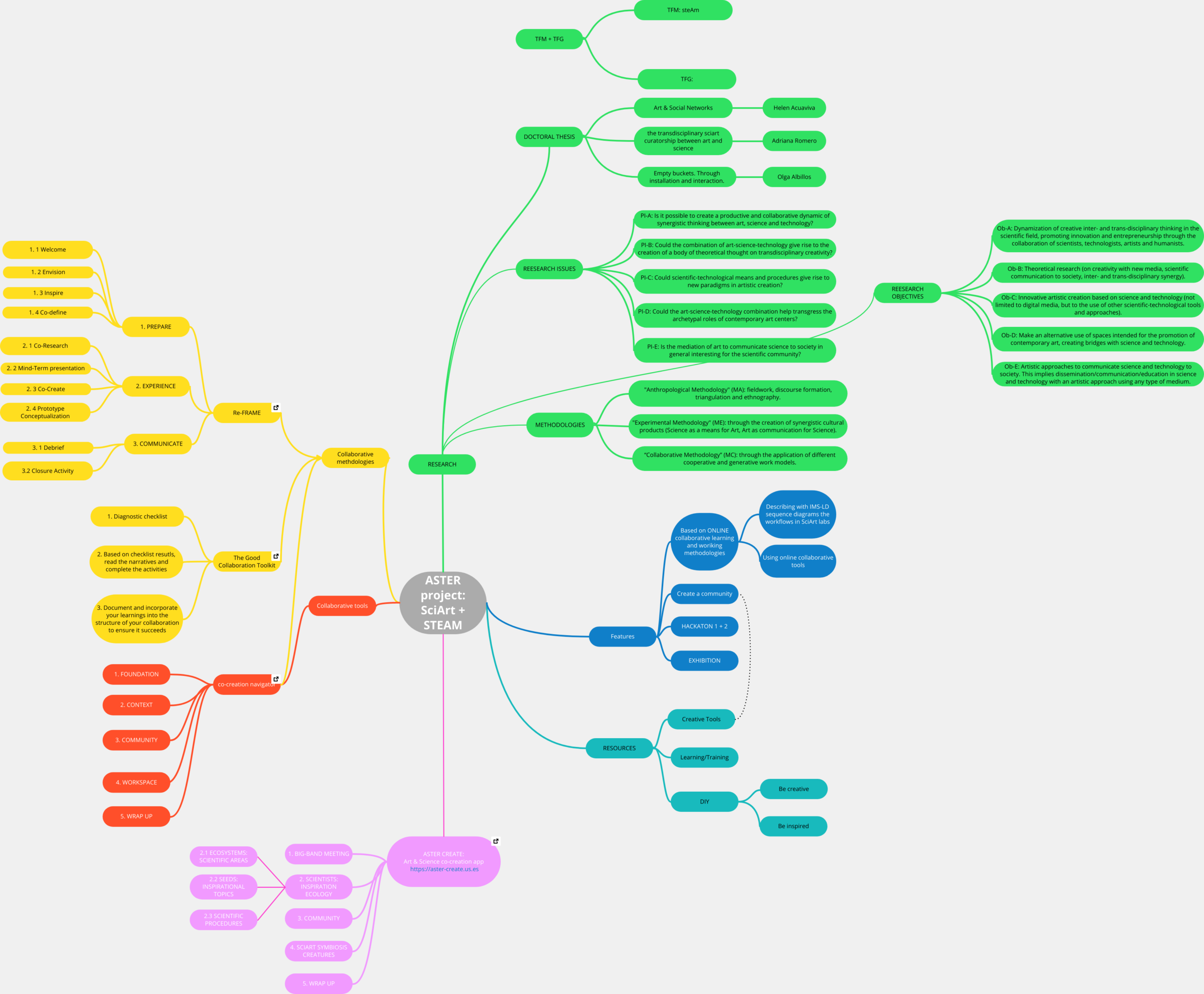
Art-Science-Technology-Society


Promoting Art-Science-Technology-Engineering Research by using collaborative methodologies and tools.
The ASTER Promoting Art-Science-Technology-Engineering Research by using collaborative methodologies and tools (US-1381015) research project is funded through the European Regional Development Fund (ERDF) and the Consejería de Transformación Económica, Industria, Conocimiento y Universidades de la Junta de Andalucía, within the Operational Program ERDF 2014-2020.
We explain the ASTER Project at a glance: access the CONCEPTUAL MAP
ABOUT THE PROJECT:
«In art and science, teamwork has become much more important than the historical notion of genius normally attributed to the traditional artist or scientist» (Jill Scott, 2006)
ASTER is a mediating project, which proposes an innovative approach to address the synergy and discussion between different disciplines of knowledge in a ubiquitous way (face-to-face, blended or distance) and with temporal flexibility (synchronous or asynchronous). Based on the ethnographic study of the dynamics followed by some of the main European laboratories in which the SciArt and STEAM synergies are regularly worked on, patterns of collaborative work will be extracted and scenarios will be designed to foster this collaboration.
ASTER is made up of a total of 20 people, including researchers, collaborators and technical and research support, and has its formative extension in the Master’s Degree of the University of Seville entitled Learning, creation and scientific-artistic communication through ICT: promoting STEAM + SciArt projects.


ABSTRACT
In a world as complex as the contemporary one, inter- and transdisciplinary research, based on the synergy Art-Science-Technology-Society (better known today with the terms SciArt and STEAM), makes more and more sense, since the creation of bridges of knowledge between different fields of study is proving to be a sure formula towards innovation and the advancement of society. On the one hand, science and technology could be considered as a source of inspiration and a medium for certain artists who, with their creations, bring closer and facilitate the understanding and reflection of the underlying scientific-technical and humanistic-artistic culture. On the other hand, art and design can act as catalysts for the creative approaches of scientists and technologists to discover new knowledge, invent innovative solutions and communicate their findings to society. From the ASTER project we propose methodologies, offer creative resources and promote activities aimed at facilitating possible symbiosis between Art-Science-Technology-Society.
When we were developing the project, the research team wondered:
RESEARCH QUESTIONS
1 Is it possible to create a productive and collaborative dynamic of synergistic thinking between art, science and technology?
2 Could the art-science-technology combination give rise to the creation of a corpus of theoretical thinking on transdisciplinary creativity?
3 Could scientific-technological means and procedures give rise to new paradigms in artistic creation?
4 Could the art-science-technology combination help to transgress the archetypal roles of contemporary art centers?
5 Is the mediation of art to communicate science to society at large of interest to the scientific community?
GOALS
Linked to the above questions are the objectives we seek to achieve:
1 Dynamization of creative inter- and trans-disciplinary thinking in the scientific field, promoting innovation and entrepreneurship through the collaboration of scientists, technologists, artists and humanists.
2 Theoretical research (on creativity with new media, scientific communication to society, inter- and trans-disciplinary synergy).
3 Innovative artistic creation based on science and technology (not limited to digital media, but to the use of other scientific-technological tools and approaches).
4 To make an alternative use of the spaces destined to the promotion of contemporary art by creating bridges with science and technology.
5 Artistic approaches to communicate science and technology to society. This implies dissemination/communication/education in science and technology with an artistic approach using any type of media.
METHODOLOGICAL APPROACHES
METHODOLOGY
ASTER is openly situated within an integrative transdisciplinary art-science (SciArt/STEAM) model, which encompasses three methodological approaches:



Anthropological Methodology (AM)
Fieldwork, discourse shaping, triangulation and ethnography.
Experimental Methology (EM)
Through the creation of synergistic cultural products (Science as a medium for Art, Art as communication for Science).
Collaborative Methodology (CM)
Through the application of different cooperative and generative work models.
HOW ARE WE GOING TO DO IT?
The ASTER project proposes the use of some methodologies and tools for collaborative work and creation to support synergy and discussion between STEAM and SciArt. For this, at a theoretical level, the international specification IMS-Learning Design (IMS-LD) will be used to design the collaborative experiences; at a practical level, some ICT tools for collaborative work and creation will be used to give synergic support to scientists-technologists and humanists-artists. It is, therefore, a mediating project, which proposes an innovative approach to address synergy and inter and transdisciplinary discussion, in a ubiquitous way (face-to-face, blended or distance), and with temporal flexibility (synchronous or asynchronous). From the ethnographic study of the dynamics of some European laboratories that usually work in this STEAM and SciArt synergy, patterns of collaborative work will be extracted, and scenarios will be designed to foster creative experimentation and collaboration between artists, scientists, technologists and society as a whole.
HACKSCIART ASTER
In addition to the online collaborative environment through which anyone can participate at any time and from anywhere, ASTER’s star activity will be a Hackathon-SciArt in which we intend to bring together artists with scientists, engineers and technologists in order to create symbiosis between different areas of knowledge and obtain creative and innovative results in the form of artistic works.
The hackathon SciArt will be held during the month of October 2022, in a hybrid way, online and face-to-face, based at the School of Computer Engineering (ETSII) of the University of Seville.
After its end, a selection will be made among the artistic works produced during the Hackathon-SciArt, with which a final exhibition ASTER>ARTE^CIENCIA will be held in the Colegio Oficial de Aparejadores y Arquitectos técnicos of Seville.
The scientific topics around which the Hackathon-SciArt will revolve will be:
Artificial Intelligence
Environment
timeline

